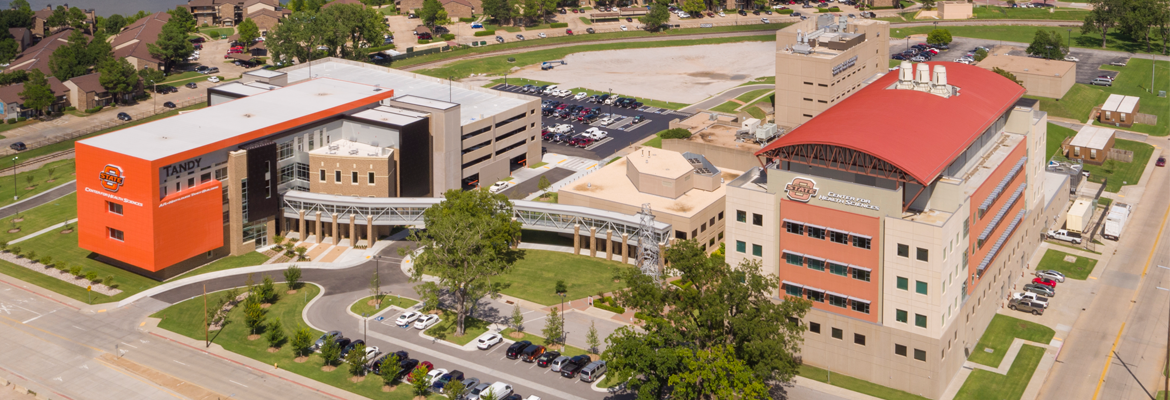
Vanguard: Shining the light on research
Thursday, February 11, 2016
Video series highlights the wealth of exploration at OSU Center for Health Sciences in Tulsa.
Oklahoma State University Center for Health Sciences has focused on becoming the premier biomedical research institution in northeastern Oklahoma because research is the life blood of a university environment, lending a vitality and richness that is absent without academic exploration.
“Research is at the core of learning. This search for knowledge is learning in its purest sense,” says Bruce Benjamin, OSU-CHS vice provost for graduate programs, associate dean for biomedical sciences and associate professor of physiology. “Such exploration stimulates the mind and is necessary for finding answers to important questions.”
To showcase that research and fulfill the university’s land-grant mission, Research Spotlight, an ongoing video series, highlights the diverse spectrum of faculty research at OSU-CHS. Each video focuses on an individual researcher’s work. Videos on each research project are posted to the OSU Center for Health Sciences’ website along with accompanying stories and are featured on OState.TV.
“A strong research program enables faculty to be engaged in and aware of the latest knowledge in their respective fields and generates enthusiasm that benefits students and faculty,” Benjamin says. “This series offers a glimpse into all of the important work going on at OSU-CHS and the potential this research has to improve lives and help us live healthier, safer lives.”
Each researcher is faced with a challenge: take a complex project and break it down for viewers into a short, easily understood presentation.
Most begin with a quest to find an answer to a specific question: How can we better predict cardiovascular disease? How can snake antivenom be improved? What do the lives of dinosaurs millions of years ago tell us about animals today?
Each of those questions, representing a line of research at OSU-CHS, has been highlighted in Research Spotlight.
Charles Sanny, chair of the OSU-CHS Department of Biochemistry and Microbiology and biochemistry professor, found out firsthand how expansive the outreach series has been.
His research into the effectiveness of snake antivenom that could lead to improved treatment options for those bitten by a poisonous snake was featured in the series. In a state with seven types of venomous snakes, including the diamondback rattlesnake, cottonmouths and copperheads, Sanny’s work hit a nerve.
Stories about his research were widely disseminated throughout Oklahoma through various media outlets.
“Anyone visiting the OSU-CHS website is able to get understandable and informative introductions to our research by the actual scientists themselves,” Sanny says. “The Research Spotlight series is a great way to showcase the many exciting research efforts that are going on here at OSU-CHS.”
Rashmi Kaul, Ph.D., whose research has garnered more than $150,000 in support from a local cancer charity, has been featured in a Research Spotlight video for her efforts to determine the link between hepatitis C and liver cancer.
“Research is a creative endeavor which brings innovative ideas to solve a problem. And for that purpose, universities serve as temples of education for our future generation but also incubators of innovation,” she says. “Globally, it is becoming increasingly important that research is the best system for educating the next generation of innovators and scientists.”
Kaul believes the series informs the public about valuable and innovative research underway at the university and raises awareness about diseases that may prompt valuable feedback from community members with these conditions.
“The Research Spotlight series can identify community members with a personal interest for further research in a particular disease or condition,” she says. “They can become community champions, create awareness and facilitate funding support for the research.”
Research topics cover medicine, biomedical sciences, forensic sciences, paleontology, health care administration and athletic training.
Examples of the series include:
James Hess, chair and director of the OSU School of Health Care Administration, discussing research on new business models to help insurance companies operate successfully within a changing health care economy.
Associate Professor of Microbiology Gerwald Koehler shared his research on the trillions of microorganisms living in the human digestive tract and how they affect the central nervous system.
Associate Professor of Physiology Kathleen Curtis discussed how estrogen influences in the brain and affects physiology and behavior, building on her years of research on human hormones.
OSU-CHS continues to encourage research at the university through collaboration with the community and engagement with faculty and students.
“Research shapes our understanding of the world. It adds to the accumulation of knowledge and provides a source for new ideas and innovation across a range of multi-disciplinary areas,” Benjamin says. “Solutions to problems and cures for disease have all come about as a result of research. Sharing our work could lead to important breakthroughs that will potentially impact the lives of millions.”
